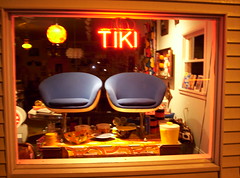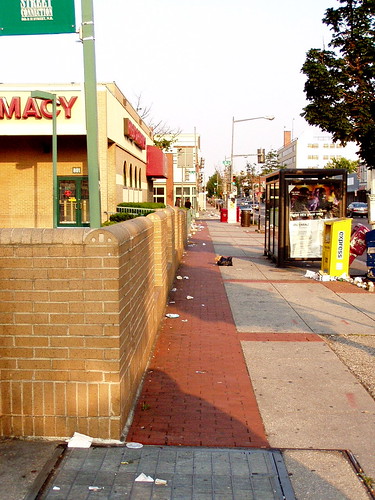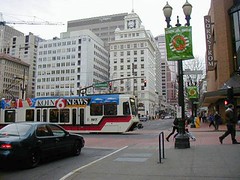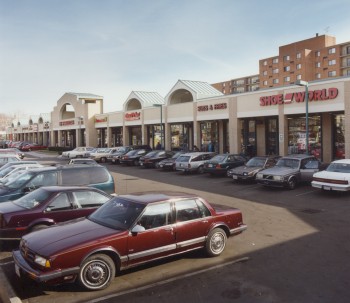Why Portland Oregon has a thriving and dynamic independent retail environment
While I have been working on this argument, recently the Wall Street Journal ran an article, entitled "Is Eminent Domain the Only Hope For Redeveloping Inner Cities?" about how eminent domain is necessary to rebuild inner cities. The story used the example of Koman Properties in St. Louis, and their construction of a strip shopping center of national chains. Otis White's e-newsletter says this (positively) about the the story:
The Journal focused on Koman Properties, a shopping center developer in the St. Louis area. Many of Koman's projects are in the suburbs and exurbs, where large tracts are easily available. But when it ventures into older urban areas, Koman finds it nearly impossible to assemble the land it needs without government help. Good example: The shopping center the company built in East St. Louis in 1999. East St. Louis is one of the poorest cities in America, a place where nearly a third of families live below the poverty line, crime is rampant, municipal corruption is legendary and, not surprisingly, new development is nearly nonexistent. But when company owner Jim Koman looked at East St. Louis in the late 1990s, he saw opportunity as well as blight: Residents there had access to only 3 square feet of retail space per capita, versus a national average of 20 square feet.
So this has been discussed on the pro-urb email list, and here is my slightly edited and expanded response:
It's greed, but also a failure to really understand how to rebuild communities successfully and sustainably. I just spent about 10 days in Portland Oregon and was amazed to see the most thriving and dynamic independent retail environment of any U.S. city that I've seen (granted there are many cities I haven't been to quite yet). I talked to a lot of people about it, and their impressions came down to the equivalent of "it's something in the water...Portlanders and their creativity," etc.
I hate explanations that come down to a perception of "uniqueness. " I think that such explanations usually fail to dig deep and suss out the reasons and potentially replicable lessons.
I thought long and hard about it, and I think I have the explanation. (1) Urban Growth Boundaries prevented the construction of speculative, credit-tenant oriented, national chain shopping centers; (2) which normally work to destroy the value of extant retail space usually of a configuration undesirable to national chains; (3) which maintained the value and attraction of extant retail space (Jane Jacobs "large stock of old buildings"); (4) which remains, for the most part, unattractive to chains; (5) allowing for the continued development and strengthening of independent retail.
 Home Economics store on Hawthorne Blvd. in SE Portland, Oregon.
Home Economics store on Hawthorne Blvd. in SE Portland, Oregon. Halloween Window at Jelly Bean on SE Hawthorne Ave.
Halloween Window at Jelly Bean on SE Hawthorne Ave. H Street Connection, Washington DC. Photo by Elise Bernard.
H Street Connection, Washington DC. Photo by Elise Bernard.I am not an expert on using data, but I imagine like East St. Louis, for the Portland Oregon metropolitan area, the amount of "per capital leaseable retail space" is less than the national average. But this merely keeps the supply and demand more balanced, and more supportive of extant space, particularly space in the center city. In other regions, there is way more space available than extant retail demand. This makes most of the "old" usually historic buildings roughly worthless in the context of the regional economy.
This is not to say that there aren't chain stores in Portland. I didn't get to the "Lloyd Center" which was Portland's urban renewal shopping mall solution from the 1980s. But I think it's telling that while Nordstrom's has a store at Lloyd Center, they have also opened a store on Pioneer Courthouse Square. There is also Fred Meyer, a homegrown in the Pacific Northwest equivalent of a Walmart Supercenter, and I saw two of these stores on my walks in various neighborhoods--I am sure there are more within the city. There are some strip centers too, on streets like W. Burnside and I am sure in other places that I didn't have a chance to visit.
 Nordstroms and Light Rail in Downtown Portland. Photo by Adam J. Benjamin. world.nycsubway.org
Nordstroms and Light Rail in Downtown Portland. Photo by Adam J. Benjamin. world.nycsubway.orgTo really nail this thesis, I would have to spend more time exploring the Portland metro, as well as coming to terms with my knowledge deficit in the acquisition of appropriate data and subsequent analysis, but I suppose that will happen down the road.
As John Norquist points out, East St. Louis could have done a much better job rebuilding its retail store environment, that there is so much available retail space in empty but usable buildings.
I am going to guess that this shopping center referenced in the article is a typical suburban-style strip center that is parking-fronted, somewhat walled off, that diminishes the pedestrian experience--disconnecting from the neighborhood and the neighborhood commercial district rather than complementing, stabilizing, and strengthening it. Plus, in terms of rebuilding the local economy, the national stores don't do much.
Sure there is local hiring, but most of the profits are repatriated elsewhere, providing little support for generating additional economic activity. And the store managers are certainly not contributing "social capital" to the development of local merchants associations, etc.
Something like the H Street Connection, pictured above and below. This center, was built in the mid-1980s in my Washington DC neighborhood. I have seen versions of this center in most of the distressed urban commercial districts around the country. And of course it is typical of the strip shopping centers that dot the arterials of most every metropolitan area across the county.
If an overall economic analysis of the impact of such centers were to be performed, comparable to the kind of work done by the community consulting group Civic Economics (see their studies of Austin Texas and the Andersonville neighborhood in Chicago) I would guess that the results would be middling, that people would be surprised at the limited economic contribution such stores make to the local economy.
"Community economic development" needs to mean a lot more than making money for a developer and national chains.
 Washington, DC's H Street Connection, owned by the Rappaport Companies of Reston Virginia. This center was built with financial support from DC-government managed HUD funding programs.
Washington, DC's H Street Connection, owned by the Rappaport Companies of Reston Virginia. This center was built with financial support from DC-government managed HUD funding programs.



0 Comments:
Post a Comment
<< Home